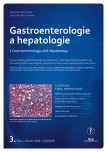Biochemical evaluation of the effect of silymarin and praziquantel on hepatic fibrogenesis during experimental larval infection of the parasitic helminth Mesocestoides vogae (Cestoda)
Authors:
S. Velebný; G. Hrčková; A. Königová
Authors‘ workplace:
Parazitologický ústav SAV, Košice
Published in:
Gastroent Hepatol 2011; 65(3): 120-125
Category:
Hepatology: Original Article
Overview
Design:
Tapeworm infection with larvae of Mesocestoides vogae causes hepatic fibrogenesis of the host during the chronic phase of disease, which cannot be eliminated using anthelmintic drugs. We investigated the effect of the anthelmintic drug praziquantel and the hepatoprotective agent silymarin on the efficacy of treatment and biochemical markers of fibrosis and liver damage/regeneration.
Methods:
Mice (males, ICR) were infected with M. vogae larvae orally (p.o). During days 15–24 post infection (p.i.) they were treated with anthelmintic praziquantel (PZQ) only or together with the hepatoprotective agent silymarin (SIL). Infected-untreated mice served as the control. Biochemical markers were analysed in the serum and livers of the mice collected within three weeks post therapy (p.t.).
Results:
It was found that in mice infected with M. vogae larvae during the follow-up of therapy with PZQ and SIL, the antioxidative capacity of the liver parenchyma and regeneration of hepatocytes was elevated significantly (p < 0.05), cell lipids peroxidation and fibrogenesis was suppressed and efficacy of the treatment increased in comparison with PZQ treatment alone.
Conclusion:
It was found that silymarin co-administration markedly reduces the amount of reactive oxygen species produced by inflammatory cells during M. vogae infection in the liver of mice, resulting in suppressed lipid peroxidation. Moreover, it contributes to the regeneration of hepatocytes, acts antifibrotically, and all these effects of SIL could contribute to the significantly enhanced larvicidal effect of PZQ. The obtained results show that simultaneous and long-term administration of the anthelmintic drug and a hepatoprotective/antioxidant agent such as silymarin are necessary for more effective treatment of parasitic infections causing hepatic fibrosis.
Key words:
aminotransferases – hepatic fibrogenesis – glutathione – collagen – hyaluronic acid – Mesocestoides vogae – lipid peroxidation – praziquantel – silymarin
Sources
1. Dubinský P, Várady M, Reiterová K et al. Prevalence of Echinococcus multilocularis in red foxes in the Slovak Republic. Helminthologia 2001; 38: 215–219.
2. White TR, Thompson RC, Penhale WJ et al. The effect of lentinan on the resistance of mice to Mesocestoides corti. Parasitol Res 1988; 74(6): 563–568.
3. Valková M. Hepatic fibrogenesis. Bratisl Lek Listy 2002; 103: 76–85.
4. Vrba J, Modrianský M. Oxidative burst of Kupffer cells: Target for liver injury treatment. Biomed Pap Med Fac Univ Palacky Olomouc Czech Repub 2002; 146(2): 15–20.
5. Vuitton D. Alveolar echinococcosis of the liver: A parasitic disease in search of a treatment. Hepatology 1990; 12 (3 Pt 1): 617–618.
6. Brůha R. Hepatoprotektiva. Klin Farmakol Farm 2006; 20: 154–157.
7. Flora K, Hahn M, Benner K. Milk thistle (Silybum marianum) for the therapy of liver disease. Am J Gastroenterol 1998; 93(2): 139–143.
8. Fraschini F, Demartini G, Esposti D. Pharmacology of silymarin. Clin Drug Invest 2002; 22(1): 51–65.
9. Velebný S, Hrčková G, Kogan G. Impact of treatment with praziquantel, silymarin and/or β-glucan on pathophysiological markers of liver damage and fibrosis in mice infected with Mesocestoides vogae (Cestoda) tetrathyridia. J Helminthol 2008; 82(3): 211–219.
10. Velebný S, Hrčková G, Königová A. Reduction of oxidative stress and liver injury following silymarin and praziquantel treatment in mice with Mesocestoides vogae (Cestoda) infection. Parasitol Int 2010; 59(4): 524–531.
11. Hrčková G, Velebný S. Flavonoid silymarin potentiates antihelmintic effect of praziquantel via down-regulation of oxidative stress and fibrogenesis in the liver. Proc World Med Conf, Malta, Sept 15–17, 2010: 250–257.
12. Uchiyama M, Mihara M. Determination of malondialdehyde precursor in tissues by thiobarbituric acid test. Anal Biochem 1978; 86(1): 271–278.
13. Yuan LY, Kaplowitz N. Glutathione in liver disease and hepatotoxicity. Mol Aspects Med 2009; 30(1–2): 29–41.
14. Han D, Hanawa N, Saberi B et al. Mechanism of liver injury. III. Role of glutathione redox status in liver injury. Am J Gastrointest Liver Physiol 2006; 291: G1–7.
15. Anthony B, Allen JT, Li YS et al. Hepatic stellate cells and parasite-induced liver fibrosis. Parasite Vectors 2010; 3(1): 60–66.
16. Aragon AA, Imani RA, Blackburn VR et al. Towards an understanding of the mechanism of action of praziquantel. Mol Biochem Parasitol 2009; 164(1): 57–65.
17. Watson M. Praziquantel. J Exot Pet Med 2009; 18: 229–231.
18. www.adcc.sk/web/humanne-lieky/pil//flavobion-pil-7451.html
19. wwww.adcc.sk/web/humanne-lieky//spc/lagosa-spc-12987.html
Labels
Paediatric gastroenterology Gastroenterology and hepatology SurgeryArticle was published in
Gastroenterology and Hepatology

2011 Issue 3
Most read in this issue
- Importance of portosystemic pressure gradient measurement (HVPG) in patients with liver cirrhosis
- Hepatocellular carcinoma – diagnosis and treatment from the medical oncology perspective
- Unusual complication of chronic pancreatitis
- Serum concentration of hyaluronic acid correlates with the degree of fibrosis and portal hypertension
